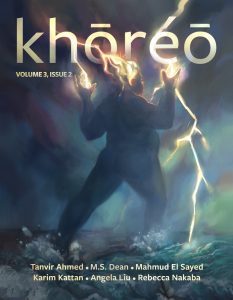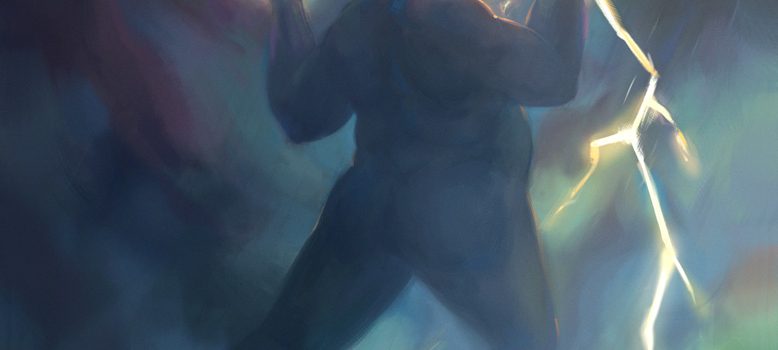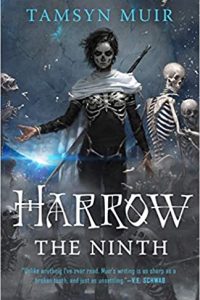A.C. Wise Reviews Short Fiction: Asimov’s, Clarkesworld and khōréō
 Asimov’s 11-12/23
Asimov’s 11-12/23
Clarkesworld 11/23
khōréō 3.2
Asimov’s November/December issue includes three novellas, along with an assortment of short stories and novelettes. The wide variety of themes and styles in this issue work well, with stories evoking classic science fiction, stories with an epic science fantasy feel, and others taking a quiet slice-of-life approach. “Berb by Berb” by Ray Nayler is one of the most effective pieces in the issue, depicting an alternate history where reverse-engineered technology from a crashed spaceship in the 1930s helped America’s war efforts. The death toll remained high, though, and alien dust escaped from containment during the reverse-engineering process led to the accidental development of berbs – creatures formed from scrap metal that learn, grow, and continually seek new material to absorb. The story is told from the perspective of one of the team members responsible for reverse engineering the alien death rays and thus also responsible for the berbs. The story does a lovely job of exploring the cost of war, including the unanticipated and indirect costs, the idea of survivor’s guilt, and the idea of taking responsibility for one’s actions, with the main character being one of the few people who tries to communicate with the berbs, rather than leaving them to raid and steal, or starve.
“The Open Road Leads to the Used Car Lot” by John Alfred Taylor is another story dealing in alternate history. At the 1939 World’s Fair, Isaac meets a mysterious woman while riding the Futurama. She has a device that looks like a guidebook, which briefly transforms into a smartphone-like device, showing images of technology and a world that doesn’t exist. The encounter leaves Isaac with a mystery for 25 years until the woman reappears in his life to offer an explanation. The story works as a nice, quiet piece of science fiction that takes a different approach to the idea of time travel and other dimensions by showing them from the perspective of a character experiencing them only from the margins.
“Embot’s Lament” by James Patrick Kelly is one of the shorter pieces in the issue, but is all the more effective for its length. The narrator, Embot, is meant to be an impartial observer of events as a woman struggles to escape her abusive husband. However, they can’t quite resist the urge to interfere, nudging the woman toward certain choices in order to help. The story works as a slice of life focused on a particular moment in time, but also as a metacommentary about voice and point of view in a story, and what role an omniscient, third-person narrator might play. It breaks the fourth wall without feeling gimmicky, and delivers on tension and emotion, while also reflecting on the mechanics of storytelling.
“The Ghosts of Mars” by Dominica Phetteplace, one of the novellas in the issue, effectively explores isolation, the challenges of settling a new planet, and the nature of ghosts. Paz is a young woman stranded alone on Mars, trying to keep the nascent colony going while the rest of her family returns to Earth for cancer treatments. Being born on Mars, the structure of her bones and body is different enough that she’s unable to travel. When the bots she oversees begin acting strangely, alongside other occurrences – like liquid behaving in ways it shouldn’t – she theorizes that Mars may be haunted. Further, Paz suspects that the odd happenings are linked to her father’s death, and there are certainly things about his life and the way he died that her family is keeping from her. Phetteplace puts an interesting spin on the nature of ghosts by looking at their pos sible existence through the lens of technology. A person uploading their entire consciousness and personality in order to live on after death may not be possible, but they might still leave an imprint on an artificial intelligence. At what point do the input, biases, and training methods of someone responsible for teaching bots become a haunting? How much might an artificial intelligence absorb from its creator? It’s an interesting thought experiment and contributes to the ongoing conversation within recent science fiction stories around technology, AI, and where the line between creator and creation lies.
“In the Days After” by Frank Ward is another one of the standout stories in the issue. A brief burst of unexplained radiation caused a small segment of the population to stop aging. These humans, known as Dorians, are largely shunned and resented by the rest of society. While they don’t age, they aren’t immortal, and many of them feel more burden than benefit from their condition. The story is relatively short, with the main character, Sybil, preparing to take custody of an elderly couple’s child – a child who has been stuck at one day old for over 50 years. The story packs an emotional punch and provides a less than rosy view of the science-fictional trope of immortality and eternal youth.
The November issue of Clarkesworld includes “Eight or Die (Part 1)” by Thoriya Dyer, a novella about a man named Marino who is whisked away from his imminent death in a mine collapse by two alien agents who believe he can help them track down an intergalactic criminal. The story is set to conclude in Clarkesworld’s December issue.
“Bird-Girl Builds a Machine” by Hannah Yang is a beautifully written but painful time-loop story. The second-person narrator, nicknamed Bird-Girl as a child, grows up watching her mother build a machine that her mother either can’t or won’t explain. The only thing she will say when Bird-Girl asks is “it’s for you.” Their relationship becomes increasingly strained over the years, the mother openly expressing her resentment over the way raising Bird-Girl forced her to give up her own dreams. Yang does a wonderful job of infusing the story with emotion and exploring the tension between the desire to follow one’s own path and honoring one’s obligations. The time-loop element adds an extra layer to this tension, while also exploring the heartbreaking question of whether it’s possible to make kinder choices through multiple iterations of a life, or whether certain painful events and behaviors that have shaped a person in the past are fixed and always doomed to occur.
“To Carry You Inside of You” by Tia Tashiro is a beautifully written and heartbreaking story that does a wonderful job of conveying emotion. When she was six years old, Anna was given an implant to help her be a better child actor. The implant not only fed her lines and cues, but allowed her to be “twitched” with pure emotion, feeling what the character was meant to feel rather than having to act it. When Anna is in college, her mother dies suddenly, and Anna turns to illegal twitching in order to feel. After she nearly loses control, she cuts herself off and takes a job as a surrogate host for the recently deceased, who can plug into her port in order to spend more time with their loved ones. The story is poignant, with characters who feel fully formed being forced to make difficult choices.
“The Long Mural” by James Van Pelt centers on a stowaway on a generation ship, living in constant fear of being found out, while also trying to make himself useful to the community by scrubbing away mold and other harmful substances, and contributing to the communal art project of the title. It’s a sweet story that offers an alternative to “The Cold Equations”-style story of limited resources in space and a group forced to make brutal decisions and sacrifices. “Eddies Are the Worst” by Bo Balder offers up a world of declining birthrates, where clones are used as cheap labor, and like Tashiro’s story, contemplates the possibility of a form of life after death. “The Parts That Make Me” by Louise Hughes explores memory and the ways the past is carried forward into the present and the future. Overall, this is another strong issue of Clarkesworld.
Issue 3.2 of khōréō is full of gorgeous, lyrical writing. “Come Back, Crocodile Bird” by M.S. Dean takes place in the evocative setting of a half-drowned and flooding world. Almost all of Arnaz’s family have come back as crocodiles, except her mother, who mysteriously disappeared. Her grandmother spends most of her time dreaming under the influence of rose tar, trying to discover what happened to her daughter. The world is beautifully described and the story poignant, as Arnaz is caught between her obligations to the past and her family and a way forward into the future. “Umeboshi” by Rebecca Nakaba similarly makes effective use of water-related imagery to explore ideas around family and feeling disconnected from one’s heritage and past. While traveling for work, the protagonist receives a mysterious chain email, warning them of the red tide, and stipulating that if they do not forward the message to ten of their ancestors, they will sink. There is a dreamlike fluidity to the prose that heightens the sense of being disconnected and adrift, giving the story a haunted and melancholy feel that works well with its themes.
“The Abode of the Palms” by Karim Kattan also plays with the feeling of being unmoored and is full of poetic and striking imagery. The young protagonist travels to the realm of the jinn, where they are meant to sacrifice their baby brother because second children are a blight on the land. Throughout the journey, they appeal to their supernatural companions and try to find a way to avoid the terrible duty they’ve been given. “Sartor” by Tanvir Ahmed also concerns a journey with an epic feel, in this case, one undertaken by the disembodied head of a murdered dervish. Sartor was once one of 40 severed heads placed in a cave and brought offerings by the locals in exchange for bringing the land prosperity. After a desperate widow tries to steal one of the heads, the head is exiled from the cave. The head, now known as Sartor, is forced to reckon with a new idea of selfhood and purpose, no longer being one-of-40 or belonging to the cave.
“Kwong’s Bath” by Angela Liu is one of the standouts in an issue that is overall full of strong and lovely stories. After her first upgrade surgery meant to give her access to the Floating City and a better life, Kwong begins seeing ghosts. This unintended side effect may prevent her from completing the process, much to her parents’ dismay, as being chosen for upgrades is an honor. The identity of the narrator, revealed partway through, adds an extra bittersweet dimension to the story as it explores complicated family relationships, class mobility, and what people are expected or forced to leave behind for a chance at a better life. “Memories of Memories Lost” by Mahmud El Sayed, which similarly deals with complex family relationships, loss, and sacrifice, is another of the standouts in the issue. In a society where everyone must pay a memory tax to the alien invaders who have settled on Earth, Ahmed chooses to make his payment with a family heirloom. It means losing a bigger memory, but it will earn him enough credit to take his father, who is suffering from dementia, back to Cairo to live out his remaining days and ultimately be buried. The story offers a beautiful and occasionally heartbreaking exploration of the nature of memory and how love and pain can often be intertwined. Getting rid of certain traumatic memories of his father is both a relief and a source of regret for Ahmed. It shifts their relationship from a complicated and troubled one, paralleling his father’s own natural memory loss to one focused on fulfilling his father’s last wishes, unburdened by the past.
Recommended Stories:
“Memories of Memories Lost”, Mahmud El Sayed (khōréō 3.2)
“Kwong’s Bath”, Angela Liu (khōréō 3.2)
“To Carry You Inside of You”, Tia Tashiro (Clarkesworld 11/23)
“Bird-Girl Builds a Machine”, Hannah Yang (Clarkesworld 11/23)
“In the Days After”, Frank Ward (Asimov’s 11-12/23)
“Berb by Berb”, Ray Nayler (Asimov’s 11-12/23)
A.C. Wise is the author of the novels Wendy, Darling, and Hooked, along with the recent short story collection, The Ghost Sequences. Her work has won the Sunburst Award for Excellence in Canadian Literature of the Fantastic, and has been a finalist for the Nebula Awards, Stoker, World Fantasy, Locus, British Fantasy, Aurora, Lambda, and Ignyte Awards. In addition to her fiction, she contributes a review column to Apex Magazine.
This review and more like it in the December and January 2023 issue of Locus.
 While you are here, please take a moment to support Locus with a one-time or recurring donation. We rely on reader donations to keep the magazine and site going, and would like to keep the site paywall free, but WE NEED YOUR FINANCIAL SUPPORT to continue quality coverage of the science fiction and fantasy field.
While you are here, please take a moment to support Locus with a one-time or recurring donation. We rely on reader donations to keep the magazine and site going, and would like to keep the site paywall free, but WE NEED YOUR FINANCIAL SUPPORT to continue quality coverage of the science fiction and fantasy field.
©Locus Magazine. Copyrighted material may not be republished without permission of LSFF.








